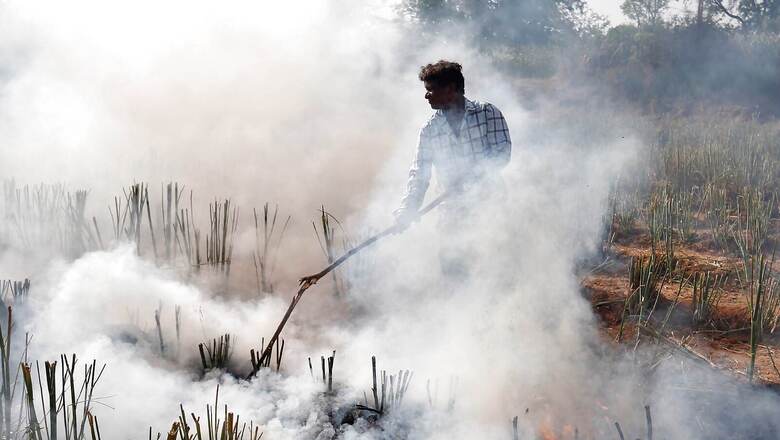
views
Punjab’s chief minister has not only withdrawn FIRs against farmers burning crop stubble, but also announced Rs 2 lakh reward for rioters who beat up police and desecrated the Red Fort on Republic Day. While on the surface this seems like politics as normal, the reality is Punjab is sliding down a vortex—a vortex that presages the re-emergence of terror and chaos. Sadly, in the cynical politics for electoral gains, India and the average Indian citizen are going to become the victims. To understand what is happening, we need to understand two cycles of toxicity—the first is the centrifugal caste politics of Punjab and the second is the centripetal fallout of crop burning happening outside of Punjab. When these two come together, it is essentially taking the matchstick to the gunpowder.
Ostensibly, the FIRs in the crop stubble burning cases have been withdrawn to prevent farmers from voting for Captain Amarinder Singh and splitting the Congress vote share. The rationale is that Jat Sikhs tend to dominate Punjab’s polity, not allowing a toehold to Dalit Sikhs and Sikh social movements that have represented non-Jat interests, like the Nirankaris, the Ravidasiyas and the Deras, all conveniently labelled heretics. That Charanjit Singh Channi, a Dalit Sikh, is the chief minister of Punjab would anyway cause significant angst among the economically and institutionally dominant Jat Sikhs. On account of being a Dalit Sikh with an uphill task of getting Jat Sikh votes, this is just the beginning of Channi’s campaign of appeasement. The problem is the path this will lead to.
During the peak of the farmer protests when we were analysing satellite imagery, one thing became very clear. The numbers at best were between 200 and 300,000 depending on tent occupation density and spread, nowhere near the “mass uprising” that was being advertised. Similarly, the flow of people seemed seasonal with “replacement protesters” showing up every few months while fatigued “protestors” were removed for the required harvest season labour. In essence, this wasn’t a mass protest but a well-funded charade by the dominant land-owning Jat Sikhs using their muscle and money power to force tenants and paid labour to come and protest in lieu of labour. It is this same dominant community, which largely comprises primary land owners, that presumably also accounts for most of the crop stubble burning. Unsurprisingly, the popularity of terrorism that gripped the state through the 1980s and 1990s was also the highest among this strata. We need to remember that Bhindranwale and his ilk committed as many atrocities against “heretic Sikhs” as they did on Hindus—indeed, their first victims were invariably Nirankaris.
Today, there is a gradual re-emergence of the feudal power structures which we believed had been ameliorated by the ending of the Punjab insurgency. It has all the required components—funding, both local and foreign, government aid and support for outright criminality, wilful ignorance of the powers that be, a cause to rally around—that cause having strengthened the hands of the latent feudal structures that are now able to extract corvée with impunity under the guise of ideology, and governments that leave the victims to the mercy of these landlords. If anything, the Rs 2 lakh gift to the terrorists who violated the sanctity of Republic Day will act as an incentive—the message being the more outrageous your actions, the more we will look after you.
The second layer to this is the crop stubble burning and its seeming encouragement by the Punjab government. On one hand, having made this about “livelihoods” without proffering solutions like mobile shredding machines that can be shared by the community or composting at the village level, the farmers view this as a desperate last stand. On the other hand, the fact that these farmers’ livelihoods mean cancer, respiratory diseases and a whole host of issues for an estimated 300 million of India’s most productive population has led to significantly hardened attitudes. Add to it judicial and governmental pusillanimity, and this is a toxic cycle of appeasement, inaction and cowardice all feeding directly into the alienation and “us versus them” that is playing out. Needless to say, the alliance of convenience between Khalistanis and the ISIS that has been in place since the 1980s is holding strong and gaining significantly—as exemplified by the opening of the Kartarpur corridor that many had warned was a Trojan horse.
Ultimately, we need to take a long hard look and hold our governments responsible and demand immediate corrective measures. At some point, governments need to learn that public riots once stoked become impossible to control. They also need to learn that by not taking action early, they only delay the inevitable that ends up becoming a lot worse. At any rate, if something isn’t done soon, we should be prepared to return to the dark days of 1980s’ Punjab.
Abhijit Iyer-Mitra is Senior Fellow at the Institute of Peace and Conflict Studies. The views expressed in this article are those of the author and do not represent the stand of this publication.
Read all the Latest Opinions here




















Comments
0 comment